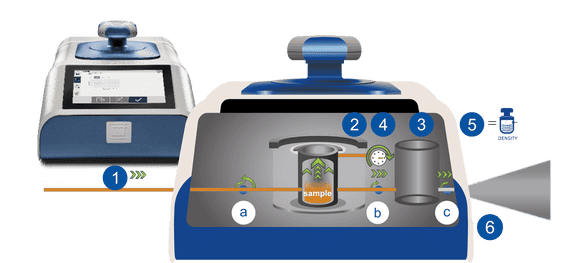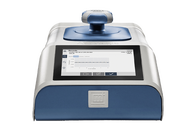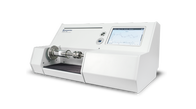

Accurate density measurement solutions for precise material characterization

At Malvern Panalytical, we offer state-of-the-art Micromeritics instruments and expert application support to deliver precise density measurements across a wide range of applications. These globally trusted tools ensure accurate and reliable results for your material characterization needs.
Density is defined as the mass per unit volume of a material. While the volume of a solid can be determined by measuring its dimensions, many materials possess surface irregularities, fractures, and pores—some accessible from the surface and others enclosed within the structure. These features influence the overall volume and lead to various definitions of density:
A non-destructive technique that uses gas displacement to accurately measure volume, ideal for obtaining true, absolute, and skeletal densities.
Inert gases like helium, nitrogen, or air fill the empty spaces within and between sample particles. The change in pressure after expanding the gas into a reference chamber allows for precise volume calculations.
Our AccuPyc Gas Displacement Pycnometer offers the fastest, easiest, and most accurate measurements of true density.

At Malvern Panalytical, we offer advanced and reliable Micromeritics instruments that provide the most accurate density measurements for a range of applications. Explore these high-performance systems below:

The fastest, easiest, most accurate measurement of true density
The AccuPyc system utilizes gas displacement pycnometry to measure the true, absolute, and skeletal densities of a wide variety of materials with unmatched speed and precision. Using an inert gas, typically nitrogen or helium, the system precisely calculates the volume of even the smallest pores in a material by measuring the pressure changes in a sealed chamber. This method is ideal for solids, powders, and porous materials. With its automated operation and minimal sample preparation, the AccuPyc delivers fast, reproducible results with high sensitivity, making it the gold standard in density measurement for industries such as pharmaceuticals and materials science.
Key Features

Envelope volume and density of formed pieces and compressed powders
The GeoPyc system provides envelope density and T.A.P. (similar to tap) density measurements, essential for understanding bulk properties like packing density and the effect of consolidation forces on materials. This system uses the unique principle of Dry Flo - a non-hazardous material composed of small, rigid spheres that displace the sample’s volume - to measure envelope density.
The GeoPyc is especially effective for measuring formed pieces such as powders, granules, tablets, and solid materials without needing hazardous or liquid materials like mercury. Its versatility and easy-to-use design make it ideal for industries such as pharmaceuticals, food, and ceramics, where accurate density measurements are crucial for product quality control.
Key features

Density and porosimetry analysis for mesoporous and macroporous materials
The AutoPore V system combines mercury intrusion porosimetry with precise density measurement capabilities, offering a comprehensive analysis of materials with meso- and macro-porous structures. By measuring the volume of mercury intruding into a material under pressure, this system provides detailed information about pore size distribution, porosity, and density, essential for characterizing materials like catalysts, ceramics, and porous metals.
The AutoPore V is ideal for applications where understanding the relationship between porosity and density is crucial for performance, such as in the development of advanced materials, filtration systems, and battery components.
Key features

Micromeritics AccuPycThe fastest, easiest, most accurate measurement of true density |

Micromeritics GeoPycEnvelope volume and density of formed pieces and compressed powders |

Micromeritics AutoPore VDensity and porosimetry analysis for mesoporous and macroporous materials |
|
|---|---|---|---|
| Measurement type | |||
| Density | |||
| Technology | |||
| Dry powder displacement | |||
| Gas displacement pycnometry | |||
| Mercury intrusion porosimetry | |||